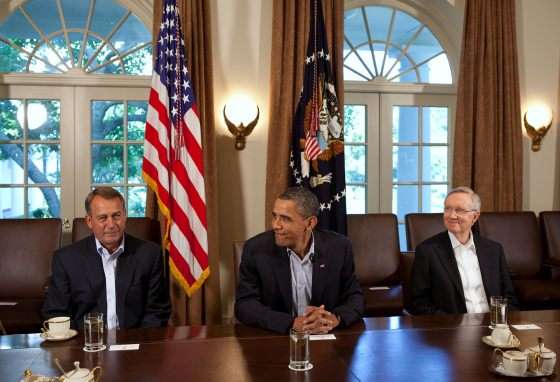By Cromnibus! The Good, the Bad, and the Ugly of the Massive New $1.1 Trillion Spending Bill

To get an idea of just how massively lame our federal government's budget arguments can be, it's worth looking over The New York Times' coverage of the budget wrangling that led up to the release last night of the $1.1 trillion "cromnibus" spending bill that's now expected to pass, keeping the government open while spending tons of taxpayer money on Stuff Government People Like.
One Times story, released late on Monday as the details of the deal were coming into view, framed the budget deal as a sort of trade-off: Republicans would agree to avoid a shutdown, but in exchange, they would "extract a policy price from Democrats." What did the GOP want out of the deal? The relaxation of "standards on school lunch content and the Environmental Protection Agency's jurisdiction over some bodies of water." These fights, the story explained, were "more contentious than the negotiations over money." Forget overall spending levels, right? These are the sorts of high-stakes policy battles consuming the nation's capitol.
The bill's complete text was finally released last night. It combines 11 appropriations bills (an omnibus) with a short-term continuing resolution (CR) just for the Department of Homeland security (omnibus plus).
I don't recommend reading it. Those who do will find a 1,600-odd page guide to how to spend more than $1 trillion other people's money (not like anyone in Congress really needs one).
Naturally, House Appropriations Committee Chairman Hal Rogers (R-Ky.) and his Democratic partner in the Senate, Barbara Mikulski (D-Md.) released a joint statement of self-congratulation. "While not everyone got everything they wanted," the pair said, "such compromises must be made in a divided government. These are the tough choices that we must make to govern responsibly and do what the American people sent us here to do."
It's not all terrible. But it's not great either. Here's a roundup of some highlights and lowlights from the proposal:
The Good:
The bill reins in Obamacare's risk corridors—widely known as its insurance industry bailouts—requiring them to be budget neutral. The Obama administration can still pay insurers under the plan, but only from the insurer user fees that are paid in, and not from slush funds like Obamacare's public health and prevention fund.
The bill cuts the budgets for the Environmental Protection Agency by $60 million and the Internal Revenue Service by $345 million. It holds the Federal Communications Commission (FCC) budget flat for the fourth year in a row.
The Bad:
Technically, the cromnibus sticks to the spending caps in last year's Ryan-Murray budget deal, coming in at around $1.01 trillion. That deal, however, was itself a way of subtly weakening existing spending caps that had been put in place through the sequestration process. But the bill also includes an additional $64 billion in overseas contingency funding for the military, as well $5 billion in emergency funding to pay for recently ramped up military operations (war) against ISIS. There's also another $5.4 billion to fund Ebola operations.
Naturally, with so much money in play, the bloated bill is packed full of goodies—or, as Sen. John McCain put it, it's "jammed full of shit." You can see for yourself by perusing the Senate Appropriations Committee summary: $25 million for "school meal equipment grants," $1.7 billion in "water and waste loans and grants," a $37 million increase in funding for the Food and Drug Administration, $6.1 billion in ownership and operating loans to farmers, $871 million for the Animal and Plant Health Inspection service (an increase of $49 million), an $81 million increase in FBI salaries and a $21 million pay bump at the Drug Enforcement Agency, $7 million in new anti-heroin funding, $3.2 billion to improve federal weather prediction, $141 million for a "next generation computing" program at the Department of Energy, a $53 million bump—up to $2.61 billion—for the National Park Service. There's more, so much more—1,603 pages worth, to be precise. Maybe some of it is worth doing, but the rolled-into-one omnibus approach means that Congress will be trying to pass it all at once in a two-day period, ensuring a scattered focus on trivial political point-scoring rather than a measured consideration of the overall merits of any proposal
The Ugly:
The spending bill shuts down the District of Columbia's plan to legalize pot, which the city's residents overwhelmingly favored in a November vote. According to a summary released by the House Appropriations Committee, the bill "prohibits both federal and local funds from being used to implement a referendum legalizing recreational marijuana use in the District." There's plenty of stupid, petty stuff buried in the spending plan, but this might be the stupidest, pettiest item of all.


Show Comments (49)